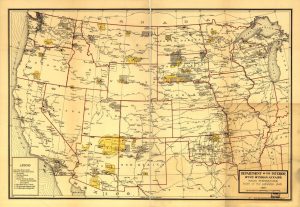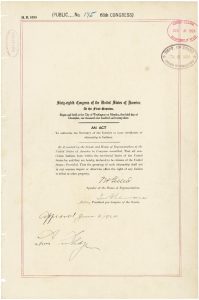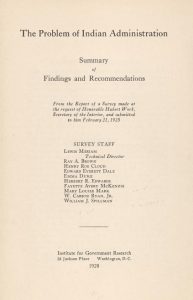United States Office Of Indian Affairs. Indian Reservations west of the Mississippi River.

This document is a map of the United States of America. More specifically, it shows the location and size of all the Native American reservations west of the Mississippi River in 1923. When compared with maps of Indian territory and reservations throughout the 19th century it becomes obvious that the United States government managed to acquire nearly all the territory previously held by Native Americans. This loss of land is a direct result of the Dawes act which allowed tribal land to be allotted to both Native American tribe members as well as white citizens.This is especially important when considering that many of these reservations experienced significant poverty as a result of the loss of land. In fact, some of these reservations are still considered impoverished areas to this day. Native tribes in 1850 owned nearly half of what is considered today to be the complete United States; however, only 75 years later only a small fraction of that land was still in the hands of Native people. This map was likely a resource for government officials dealing with the Native populations in the Untied States.
United States Congress, An Act to authorize the Secretary of the Interior to issue certificates of citizenship to Indians. 1924

The Indian Citizenship Act of 1924 or the Snyder Act was a billed passed by congress that granted citizenship to all Native Americans born within the United States. This bill was written by Representative Homer P. Snyder and signed into law by United States President Calvin Coolidge. This act may seem like an obvious success for the Native American population; however, citizenship was not wanted by many Native Americans, in fact sovereignty from the United States was the goal of many Native American Tribes at the time. Since the passing of the Indian Appropriations Act of 1971, the United States government had not recognized Native American tribes as sovereign governments that can be contacted via treaty. While Native Americans now had United States citizenship, many tribes members felt that this was going in the wrong direction and was just another attempt at assimilation by the United States government. As will be addressed in the coming section, sovereignty from the United States government is a main focus of Native American activist groups. The intended audience of this was likely Native Americans who had been granted citizenship.
Brookings Institution, and Lewis Meriam. 1971. The problem of Indian administration.

This document is a report written in 1928 by a research group conducting a survey on the condition of Native American life in the United States. The group was headed by Lewis Mariam. He was tasked with assembling a team and conducting a survey of Native American life and writing a report. The creation of this document was funded by non-government institutions as to not be corrupted. This report detailed the poor living conditions that were a direct result of the Dawes Act and unfair policies regarding Native Americans. In this report, Mariam argues that the health of Native Americans, with only a few exceptions, are far below the standards of most American citizens. Additionally, the document reported that the land received by many American Indians via the Dawes act were not fit for cultivation, that education was needed in many reservations, and long term investment was necessary to improve these communities. The report specifically called for the reform of Indian boarding schools which were detailed as often lacking proper supplies and staffing. Regardless of this advise, Indian boarding schools would continue to be used as part of the United States Assimilation policy. This documents intended audience was high ranking government officials interested in the conditions of Native American reservations as well as the success of Native American boarding schools.
